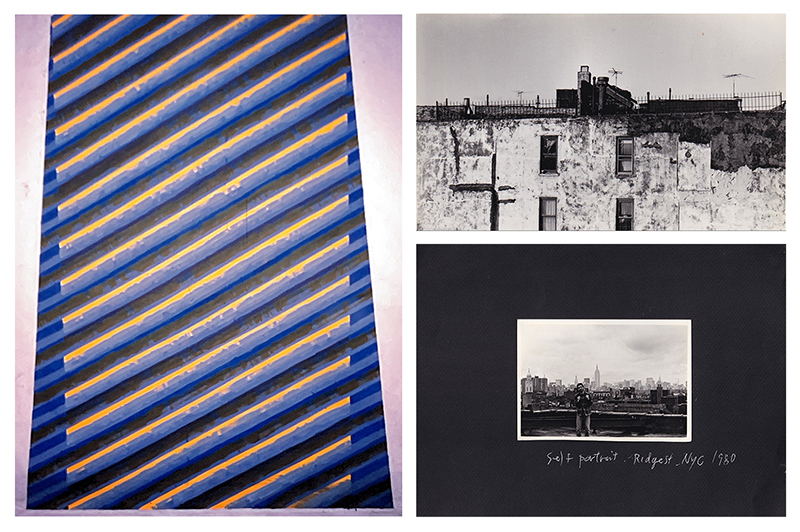FOR IMMEDIATE RELEASE
LEELA RAMOTAR & TOYO TSUCHIYA
January 22 - February 1, 2025
Opening Reception: Friday January 24, 6-8pm
Gallery Hours: Wednesday to Sunday 1:00 to 7:00 PM and by appointment
Curated by Elise Armani
Gallery Onetwentyeight is pleased to announce an exhibition of early works by Lower East Side artists Leela Ramotar (b. 1952, Guyana) and Toyo Tsuchiya (1948, Shizuoka, Japan - 2017, New York, NY).
In 1979, Ramotar moved to New York City and Tsuchiya, shortly thereafter, in the spring of 1980. Within months of their respective arrivals, both artists met Kazuko Miyamoto, artist and founder of Gallery Onetwentyeight. In 1980, the three briefly lived together in Miyamoto's loft on Chrystie Street during a pivotal moment in each of their lives: Ramotar and Tsuchiya settling in New York City after immigrating from England and Japan, and Miyamoto giving birth to her son. Tsuchiya worked under the table doing construction and fabrication for artists, while Ramotar attended the Brooklyn Museum School. In their free time, the two artists explored the city, Tsuchiya always with camera in hand. This exhibition presents paintings, photographs, and prints from the early 1980s that speak to this formative period of acclimation and transition, as both artists responded in their practices to the formal and cultural landscape of New York City. In Ramotar's geometric compositions (1980-1982), calculated combinations of color, material, and shape make reference to histories of architecture, imperialism, and pigment. In his black-and-white street photography (1980-1983), Tsuchiya documents the polarized progression of construction and collapse that characterized the city, observing the urban landscape as the towering ascendance of iconic buildings and the quiet collapse of tenements. Included in the exhibition are a series of etchings (1981) Ramotar created following the birth of Miyamoto's son, Eizan, in which bands of embroidery thread in colors "colonial brown," "baby blue," and "passive pink" are stretched across the surface of otherwise grayscale abstractions. Through the addition of colored threads, the artist transforms the prints into a meditation on gender and colonial history, making reference to a memory from her own childhood in Guyana, where she learned to embroider handkerchiefs. A series of shaped canvas paintings (1980-81), also exhibited, make reference to the striated surface of Mesoamerican pyramids and to the curved slope of the W.R. Grace Building (the latter structure is also the subject of a photograph by Tsuchiya, ca. 1980). At the time, the controversial skyscraper, constructed in 1972 beside a deteriorated Bryant Park, appeared emblematic of the ascendance of private infrastructure over public space. Tsuchiya's early photographs are characterized by a surprising spaciousness and order despite their often entropic view of the city. "Dead buildings," as the artist described them, appear as careful geometries, burned-out windows and precarious fire escapes fixed steadily into patterns and shapes. In addition to street photography, the exhibition includes a small selection of Tsuchiya's portraits and performance documentation (1980-1985) which offer a window into the artists' shared community on the Lower East Side. Tsuchiya's estate and archive are currently being cataloged by Elise Armani with the artist's family.
FOR MORE INFORMATION
please contact elisearmani@gmail.com orvisit https://www.galleryonetwentyeight.org/
ABOUT THE ARTISTS Leela Ramotar (b. 1952, Guyana) is a painter, printmaker, and educator. She studied art and education at North East London Polytechnic and St. Mary's College in London before moving to New York in 1979 to attend the Brooklyn Museum School as a Max Beckmann Scholar. From 1981 to 1983, she studied printmaking at the Pratt Graphics Center. In 1985, Ramotar participated in the exhibition RAPE, dedicated to the memory of Ana Mendieta and juried by Suan Brownmiller, Barbara Kruger, and Jenny Holzer, at the Ohio State University Art Gallery. She was a member of REPOhistory (1989-2000), a New York City-based collective of artists and educators who developed public art interventions reckoning with the construction and display of history. Ramotar was an educator in the New York City public school system for two decades. Toyo Tsuchiya (1948, Shizuoka, Japan - 2017 New York, NY) was a Japanese American artist and curator. From 1980 until his death in 2017, Tsuchiya resided on the Lower East Side among a community of immigrant artists who homesteaded vacant buildings in the 1980s and early 1990s and produced an extensive photographic and print record of an otherwise transient, largely unregistered artistic community. Before moving to New York City in 1980, Tsuchiya studied painting at Kawamara Painting Institute in Yokohama and at Osaka City Art Institute in Osaka, Japan. After taking up photography in the late 1970s, he became known for his photographs documenting performance and street art, which were circulated in publications such as The Act, High Performance, The Face, Soho Arts Weekly, and Red Tape Magazine. He was a founding member of the Rivington School (est. 1985) and his photographs illustrate the 2017 book Rivington School: 80s New York Underground. Though photography was the core of his practice, Tsuchiya revisited and repurposed his photographs in drawings, paintings, and collage, creating a large body of non-photographic works and participating in Mail Art networks in the United States and Japan. In 1999, he was awarded a Mid-Career Artist Exhibition by the Asian American Arts Center. Tsuchiya was also an active curator, organizing dozens of exhibitions throughout the 1980s and 1990s in the United States and Japan, including the 1985 apartment exhibition ASIA (Asian artists Show In A gallery) at Arleen Schloss' A Gallery, which included prominent Asian and Asian American artists Ai Wei Wei, Ming Fay, Tehching Hsieh, Kyong Park, Kazuko Miyamoto and Frog King Kwok, among others. From 1987-1990, he operated his own exhibition space, Tobe Art International Gallery, on Houston Street with Nancy Carin. Elise Armani is a doctoral candidate in Art History and Criticism at Stony Brook University, where she is writing her dissertation on immigrant artist networks and urban topography in post-industrial New York City. Her research has been supported by the American Council of Learned Societies, the Henry Luce Foundation, and the Metropolitan Museum of Art.

